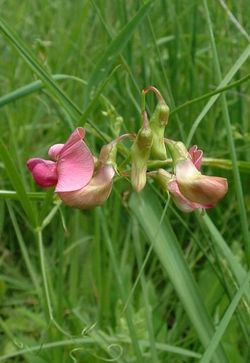Lathyrus sylvestris: Difference between revisions
No edit summary |
No edit summary |
||
| Line 1: | Line 1: | ||
{{Inc| | |||
Lathyrus sylvestris, Linn. Flat Pea. St. straggling or climbing, 3-5 ft. long, stout, winged, glabrous, with creeping rootstock: lfts. linear-lanceolate, thick, with winged lf.- stalk: peduncle 3-6-fld., equaling the leaves; flowers. 1/2 in long standard rose, with green spot on its back; wings purple at summit; keel greenish: pod lanceolate, 2-3 in. long. All summer. Eu.—Inferior ornamentally to other perennials; sometimes mentioned (in the domestic var. Wagneri) as a forage plant and for plowing under in a green state as a fertilizer. Grows well on poor, unimproved sandy soil, and is unaffected by frosts and droughts. For garden cultured, it may be sown in a seed-bed and transplanted when of suitable size. Its seeds in the wild state are said to be to some degree unhealthful, but in the cultured form this quality has been bred out. | |||
}} | |||
{{Taxobox | {{Taxobox | ||
| color = lightgreen | | color = lightgreen | ||
Revision as of 16:09, 11 July 2009
| Standard Cyclopedia of Horticulture |
|---|
|
Lathyrus sylvestris, Linn. Flat Pea. St. straggling or climbing, 3-5 ft. long, stout, winged, glabrous, with creeping rootstock: lfts. linear-lanceolate, thick, with winged lf.- stalk: peduncle 3-6-fld., equaling the leaves; flowers. 1/2 in long standard rose, with green spot on its back; wings purple at summit; keel greenish: pod lanceolate, 2-3 in. long. All summer. Eu.—Inferior ornamentally to other perennials; sometimes mentioned (in the domestic var. Wagneri) as a forage plant and for plowing under in a green state as a fertilizer. Grows well on poor, unimproved sandy soil, and is unaffected by frosts and droughts. For garden cultured, it may be sown in a seed-bed and transplanted when of suitable size. Its seeds in the wild state are said to be to some degree unhealthful, but in the cultured form this quality has been bred out.
|
| Lathyrus sylvestris {{{status}}} Fossil range: {{{fossil_range}}}
| ||||||||||||||||||||||||||||||||||||||||||||||||||||||||||||||||||
|---|---|---|---|---|---|---|---|---|---|---|---|---|---|---|---|---|---|---|---|---|---|---|---|---|---|---|---|---|---|---|---|---|---|---|---|---|---|---|---|---|---|---|---|---|---|---|---|---|---|---|---|---|---|---|---|---|---|---|---|---|---|---|---|---|---|---|
 | ||||||||||||||||||||||||||||||||||||||||||||||||||||||||||||||||||
| Plant Info | ||||||||||||||||||||||||||||||||||||||||||||||||||||||||||||||||||
| ||||||||||||||||||||||||||||||||||||||||||||||||||||||||||||||||||
| Scientific classification | ||||||||||||||||||||||||||||||||||||||||||||||||||||||||||||||||||
| ||||||||||||||||||||||||||||||||||||||||||||||||||||||||||||||||||
| [[{{{diversity_link}}}|Diversity]] | ||||||||||||||||||||||||||||||||||||||||||||||||||||||||||||||||||
| {{{diversity}}} | ||||||||||||||||||||||||||||||||||||||||||||||||||||||||||||||||||
| Binomial name | ||||||||||||||||||||||||||||||||||||||||||||||||||||||||||||||||||
| Lathyrus sylvestris L. | ||||||||||||||||||||||||||||||||||||||||||||||||||||||||||||||||||
| Trinomial name | ||||||||||||||||||||||||||||||||||||||||||||||||||||||||||||||||||
| {{{trinomial}}} | ||||||||||||||||||||||||||||||||||||||||||||||||||||||||||||||||||
| Type Species | ||||||||||||||||||||||||||||||||||||||||||||||||||||||||||||||||||
| {{{type_species}}} | ||||||||||||||||||||||||||||||||||||||||||||||||||||||||||||||||||
| {{{subdivision_ranks}}} | ||||||||||||||||||||||||||||||||||||||||||||||||||||||||||||||||||
| [[Image:{{{range_map}}}|{{{range_map_width}}}|]] | ||||||||||||||||||||||||||||||||||||||||||||||||||||||||||||||||||
| Synonyms | ||||||||||||||||||||||||||||||||||||||||||||||||||||||||||||||||||
| {{{synonyms}}} |
Lathyrus sylvestris or Narrow-leaved Everlasting-pea is a plant species of the genus Lathyrus.